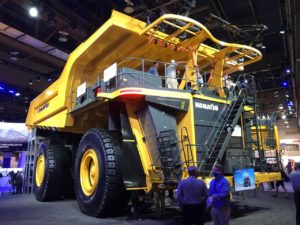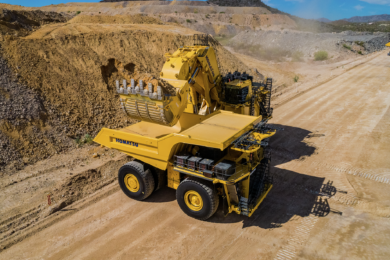At MINExpo 2021, IM had the chance to catch up face to face with both Joe Shoemaker, Komatsu Director Product Management; and Justin Bollini, Application Engineer, Surface Mining Equipment about the company’s power agnostic mining truck program and progress to date. Komatsu also had its first power agnostic development truck at the show in battery trolley configuration which was a major talking point with attendees.
Bollini commented: “This is our development platform for testing different energy sources. Right now this truck is set up in a battery configuration but we are also making it compatible with a number of alternative energy sources such as hydrogen fuel cells, battery trolley, diesel and diesel trolley plus other technologies.” The truck has been built in the most modular way possible so that different power sources can be swapped in and out: “It was made for ease of assembly and operation – if you did want to have a different option, it doesn’t mean a completely different truck. For example it will ultimately be possible to just pull the battery system out and put a diesel system in.”

Bollini said for now, Komatsu is gathering important data from the battery truck on battery run time, charge time etc adding on battery operation time “of course it depends on the haulage profile – both intensity and severity.” He said that the truck at the show, which is based on the basic 830E platform ie a 227 t machine, has been running off all battery power at its Arizona Proving Grounds (AZPG).
Komatsu has been charging it to date using a static charging capability at AZPG but at the show, Shoemaker revealed that it is was in the process of completing a test trolley line at the site. In addition, Bollini added that while the current truck is in the same class as the 830E: “all this technology is scalable; up to the 930E and above as well as down to the smaller truck classes.”
The prototype power agnostic truck is also an autonomous capable truck allowing Komatsu to see how AHS and battery operation exist together most efficiently. “When we finally release it as a commercial truck it will be available as an autonomous power agnostic truck.”
Dan Funcannon, VP North America Engineering and Development, also said at the show that the modularity enables the truck to evolve with the market and customer needs: “The idea we are developing is that you can upgrade the power source over time. The customer may begin with the truck in its traditional diesel engine configuration, then you may add a pantograph system for supplemental electric power on hills and set haul routes. When battery technology meets the needs of your operation, you can replace that diesel engine with a battery system. And down the road you could convert to hydrogen fuel cell, or whatever the future brings to the industry. The truck adapts as power technology evolves.”
On the ease of changing power sources he adds: “Our trucks have been designed with electric drives since the 1960s so you really just need to change the power source – you keep the chassis and the electric drivetrain. And we designed our trucks with an engine module that can be disconnected and slid out the front of the machine for easier and faster repair, overhaul and replacement. Our engineers said what if we use that same modularity concept to upgrade the power source? This vehicle is how we are working out the details to do this efficiently – how to build these trucks to be ready for conversions.”
Bollini would not reveal which particular battery type was installed on the truck at the show but said that it is actively testing all kinds of battery chemistries and types. Shoemaker added that eventually the agnostic program will lead to a new family of mining trucks similar to the current electric drive line-up.
Komatsu also had some infographics at the event, including one highlighting battery best practice in mining trucks: “For optimum battery performance, the temperature of the batteries must be regulated within a specified temperature range. Chillers circulate coolant to maintain optimum temperature of battery cells. The battery management system monitors battery cells, temperatures and based on feedback operates in cooling mode or heating mode, to maintain the battery cell temperature within the required operating range.”
Finally, it is important to note that the program has major industry support. Komatsu announced earlier this year that it has teamed up with several of its customers to form the Komatsu Greenhouse Gas (GHG) Alliance – namely Rio Tinto, BHP, Codelco and Boliden. The alliance’s initial target is advancing Komatsu’s power-agnostic truck concept. Rio Tinto as an example has publicly said it will conduct pre-production trials of the new equipment at a site and has the option to purchase some of the first trucks from Komatsu once they are commercially viable.










